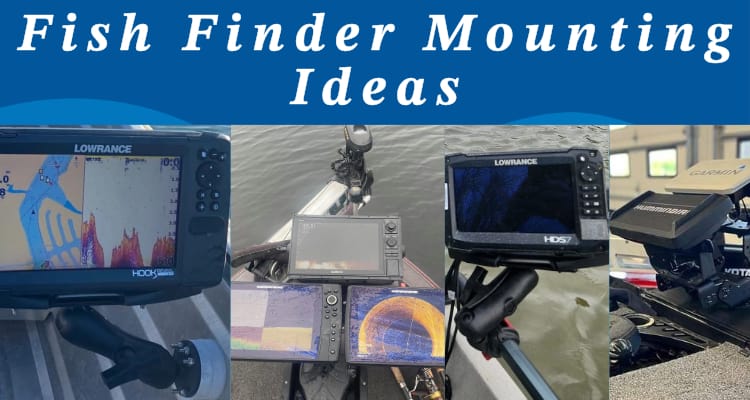I’ve put together a list of 10 fish finder mounting ideas that cater to various needs and setups, from the simplest clamp-on options to more robust solutions.
Additionally, I’ve included a simple DIY mounting setup that’s both effective and easy to put together with a few basic tools and materials. Plus, I’ve broken down different mounting options tailored specifically for various boats – from kayaks to pontoons and bass boats.
Let’s make sure you have the perfect view of where the fish are biting!
1. RAM Mount
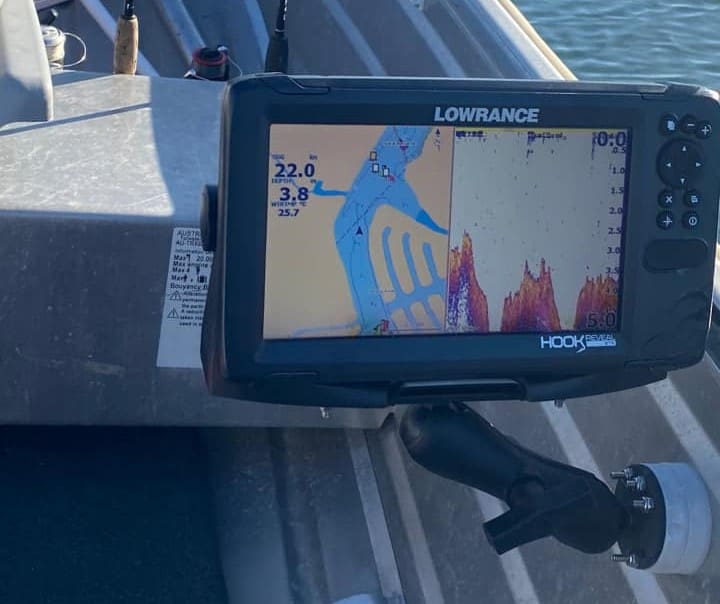
RAM Mounts is a versatile mounting system widely recognized for its durability and flexibility. It utilizes a ball and socket design that allows for nearly infinite adjustability and strong holding power.
Most modern fish finders are suitable for RAM Mounts as long as the correct mounting plate or cradle is used. It’s crucial to choose a mount that can support the weight and size of the specific fish finder. RAM Mounts offers custom cradles for popular brands and universal mounts that fit a wide range of models.
3 Best RAM Mounts for Fish Finders:
- RAM Mounts RAM-B-111U: This popular model consists of a 6.25″ x 2″ marine-grade aluminum base, a standard-length double socket arm, and a rectangular 6.25″ x 2″ plate. It’s a sturdy choice suitable for most medium-sized fish finders.
- RAM Mounts RAP-B-121-238U: Ideal for smaller boats or kayaks, this mount features a Yoke Clamp Base that can attach to any rail or edge. It’s compact yet strong and can be easily adjusted for the best viewing angle.
- RAM Mounts RAM-D-111U-C: For larger and heavier fish finders, this heavy-duty mount has a larger 3.68″ diameter round base and a long double socket arm for extra reach and adjustability. The 11″ x 3″ rectangular plate provides a stable mounting surface for even the largest devices.
2. Bow Mount
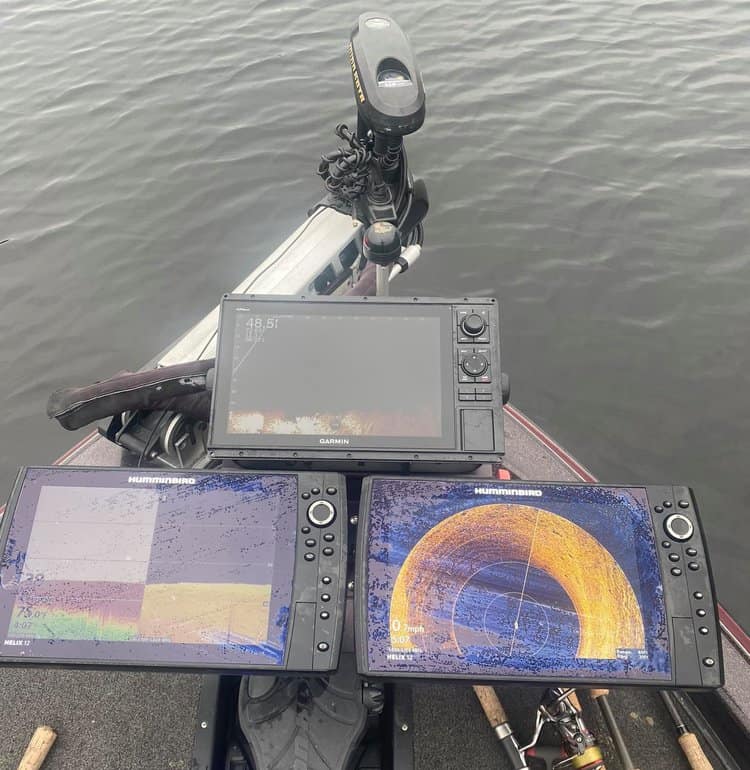
A bow mount is a type of mounting system typically used for trolling motors and fish finders on boats, positioned at the bow, or front, of the boat.
The mount typically consists of a bracket or plate that is securely attached to the boat’s bow. This can be a fixed position or offer some degree of rotation and tilt for better viewing and operation angles. The fish finder’s transducer is mounted on or near the bottom of the bow mount so it’s submerged in the water. The display unit is mounted on top, within easy view and reach of the angler.
With the fish finder mounted at the bow, anglers can easily see the display and interpret data as they navigate or cast. The forward position helps in detecting structures and fish ahead of the boat, aiding in strategic positioning.
3 Best Bow Mounts for Fish Finders:
- Precision Sonar Bow Mount Brackets
- BerleyPro Bow Mount Bro
- Procise DEK-IT Fish Finder Mounts
3. Console Mount
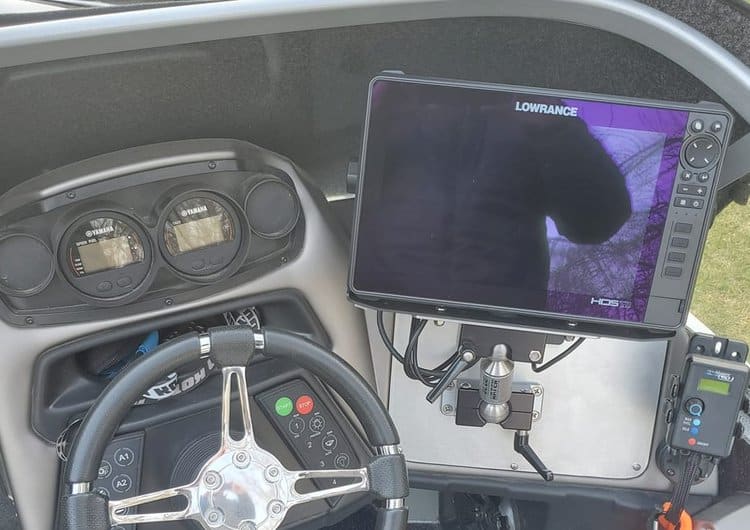
A console mount is a type of mounting system designed to secure a fish finder or other electronic devices to the console or dashboard of a boat.
This mounting method is popular among boaters who prefer to have their devices integrated into the boat’s control center for easy access and visibility. Console mounts are typically used on larger boats where the console or dashboard area provides ample space for mounting electronics.
4. Dual Mount
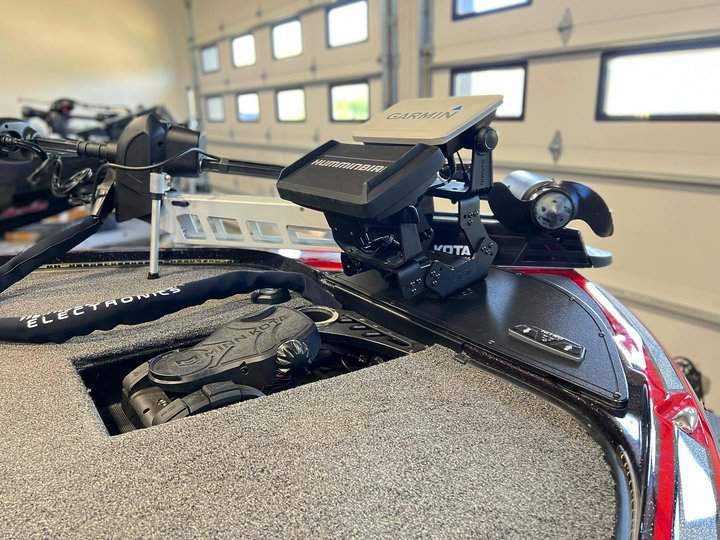
A dual mount refers to a mounting system designed to hold 2 fish finder units simultaneously. This setup is particularly popular among anglers who want to have multiple screens visible at the same time for navigation, sonar readings, and other functionalities.
Dual mounts typically have two independent arms or plates that can each hold a device. These arms are usually adjustable so that each device can be positioned for optimal viewing and accessibility. The two arms are connected to a central base that mounts to the boat. This base can be attached through various methods like drilling into the boat’s surface, clamping onto a rail, or using a suction cup.
Dual graph mounts can be used in various locations on a boat:
- Bow: Bass boats are often equipped with dual bow mounts to allow for a trolling motor and the fish finder to aid in precise navigation and fish finding.
- Console: Many boats have dual mounts at the main console for the captain’s navigation and fish finding. This setup is particularly useful for larger boats where the console is a significant distance from the bow.
- Stern: In some fishing setups, especially where anglers might be trolling or fishing off the back of the boat, dual mounts can also be useful at the stern.
5. Portable Mount
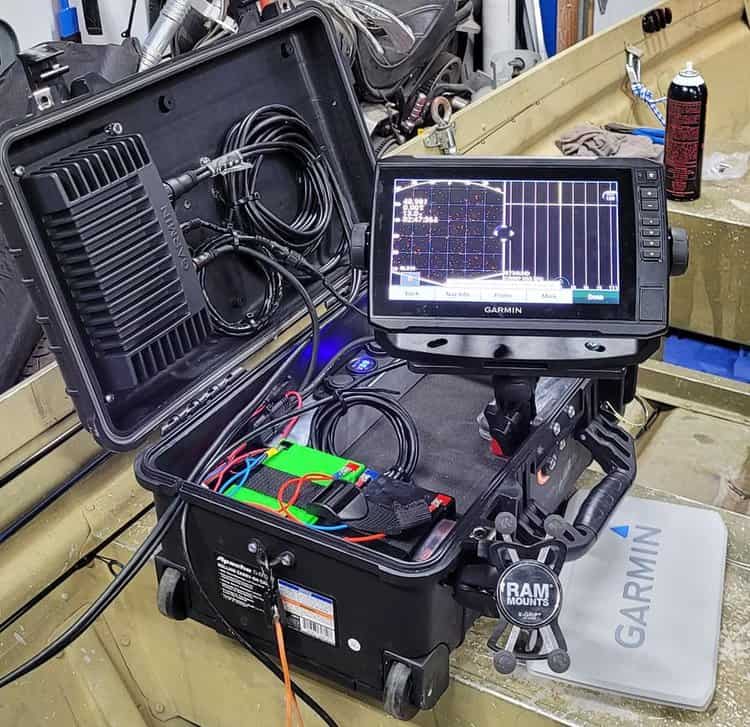
A portable mount is a type of mounting system designed for temporary or movable installation. It is popular among anglers who use rental boats, fish from multiple vessels, or prefer a non-permanent solution for their equipment.
Portable mounts often use suction cups, clamps, or other non-permanent fixtures that can be easily attached and detached from various surfaces without tools or drilling. The base securely adheres to the boat or kayak and can be removed without leaving marks or damage.
Many portable mounts include adjustable arms or swivel bases that allow users to reposition the device for optimal viewing and access. This adjustability is particularly useful when moving between different fishing spots or storing the device.
6. Rail Mount
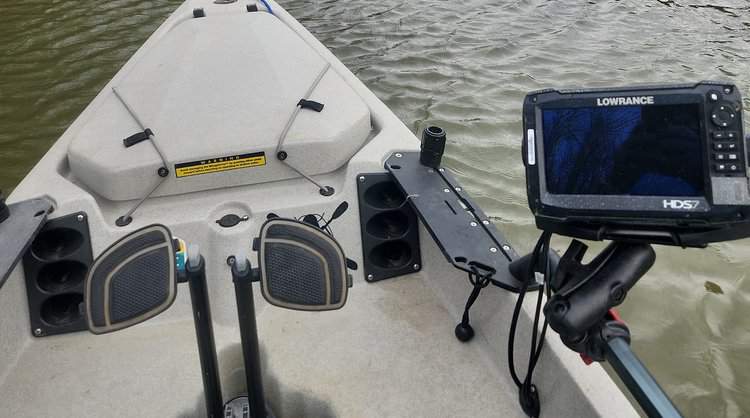
A rail mount is a type of mounting system designed to attach devices like fish finders, GPS units, rod holders, and other marine equipment to the railings or bars of a boat. These mounts are particularly popular on boats where surface space is limited or where a permanent installation is not desired. They are commonly used on sailboats, yachts, kayaks, and smaller fishing boats with railings or tubing.
Rail mounts typically use a clamping system to secure the mount to a boat’s railings or tubing. The clamp can be tightened or loosened to fit rails of various diameters, providing a stable and secure base for the mounted device.
7. Flush Mount
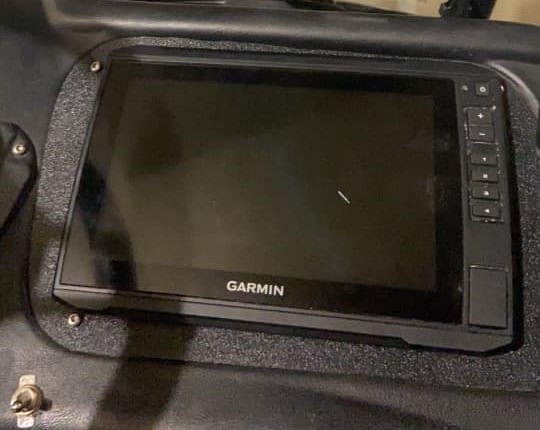
A flush mount is a type of mounting system designed to integrate devices like fish finders seamlessly into the surface of a boat’s console or dashboard. This method provides a clean, professional, and aesthetically pleasing installation by ensuring the device sits level with the surface, reducing protrusion and the chance of snagging on gear or clothing.
Flush mounts are suitable for almost any type of fish finder, from compact models to larger, more advanced units. However, the key is to ensure that the device has a suitable bezel or edge design for flush mounting and that its dimensions fit the available space on the console. It’s also essential to consider the depth behind the mounting surface to accommodate the back of the unit and its wiring.
8. Swivel Mount
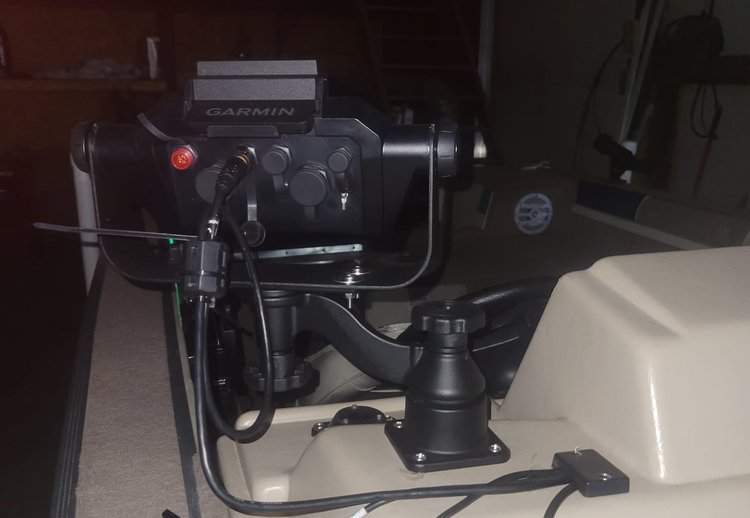
A swivel mount is a type of mounting system designed to allow rotational movement of the mounted device. It allows the user to turn the fish finder for better viewing angles and accessibility.
The core feature of a swivel mount is its ability to rotate around a central axis. This is typically achieved through a ball-and-socket joint or a pivoting hinge mechanism that allows the attached device to turn horizontally, and sometimes vertically, to various angles.
Most swivel mounts include a way to lock or tighten the swivel action to secure the device in the desired position. This can be a knob, lever, or tension screw that, when tightened, holds the mount firmly in place to prevent unwanted movement.
The base of a swivel mount is designed to be attached to a flat surface, like a boat’s console or dashboard. It can be attached through screws, clamps, or adhesive pads, depending on the design and intended permanence of the installation.
The top part of the swivel mount typically involves a plate or cradle that attaches to the fish finder or screen. This part is designed to securely hold the device while allowing for easy detachment if needed.
9. Gimbal Mount
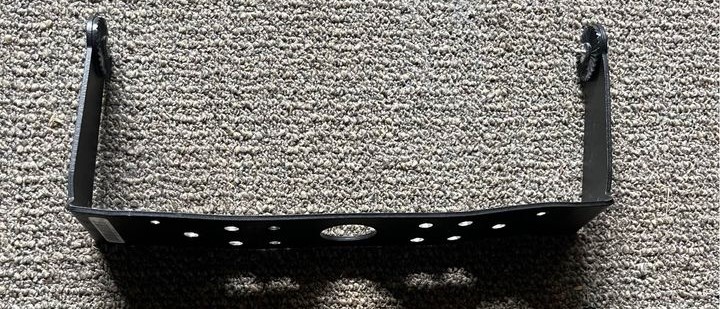
A gimbal mount is a type of mounting bracket commonly used for marine electronics, including fish finders and chart plotters. It provides a stable and adjustable platform for your device, allowing for easy viewing and access.
The base of the gimbal mount is secured to a flat surface on your boat, such as a console or dashboard, using screws or bolts. This provides a stable and permanent position for your fish finder.
The display unit sits within the U-shaped bracket. The bracket allows the device to tilt up or down and sometimes swivel side to side, providing flexibility in viewing angles. This is particularly useful for adjusting the screen for better visibility under different lighting conditions or viewing positions.
Many gimbal mounts are designed so that the fish finder can be easily detached from the bracket for storage or protection when not in use. This is useful for preventing theft or damage while the boat is unattended.
10. Heavy Duty Mount
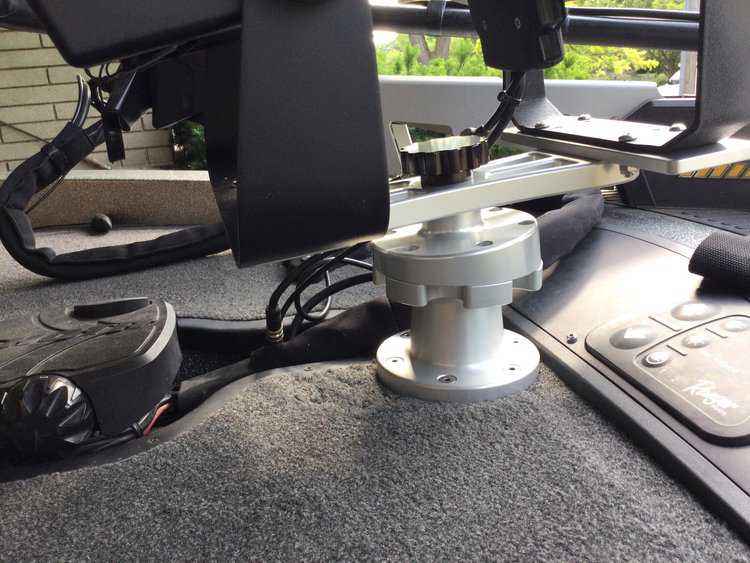
A heavy-duty mount is a robust and durable mounting system designed to securely hold larger and heavier fish finders and chartplotters. It’s particularly useful in environments where the fish finder may be subjected to high vibrations, impacts, or rough water conditions. These mounts are typically constructed from materials like high-strength composite or marine-grade aluminum to ensure reliability and longevity.
Heavy-duty mounts often have a larger and more robust base compared to standard mounts. This base can be bolted or screwed directly into the boat’s structure, ensuring a secure and stable platform that can withstand the weight and stress of larger devices.
Here are general types of heavy-duty mounts often used for larger fish finders:
- RAM Mounts Heavy Duty Series: Known for their robust designs, RAM offers heavy-duty mounts with larger ball sizes (like 2.25-inch – D size) and longer arms capable of supporting substantial weight while providing adjustability and vibration dampening.
- Scotty Mounting Systems: Scotty is well-regarded in the marine industry and offers various mounting options, including heavy-duty models that can accommodate larger devices and provide a stable base in demanding conditions.
- GeigerTec Marine Mount: Designed for larger fish finders and chart plotters, these mounts feature a sturdy construction with options for deck or side mounting, accommodating a wide range of heavy devices.
DIY Fish Finder Mounting Setup
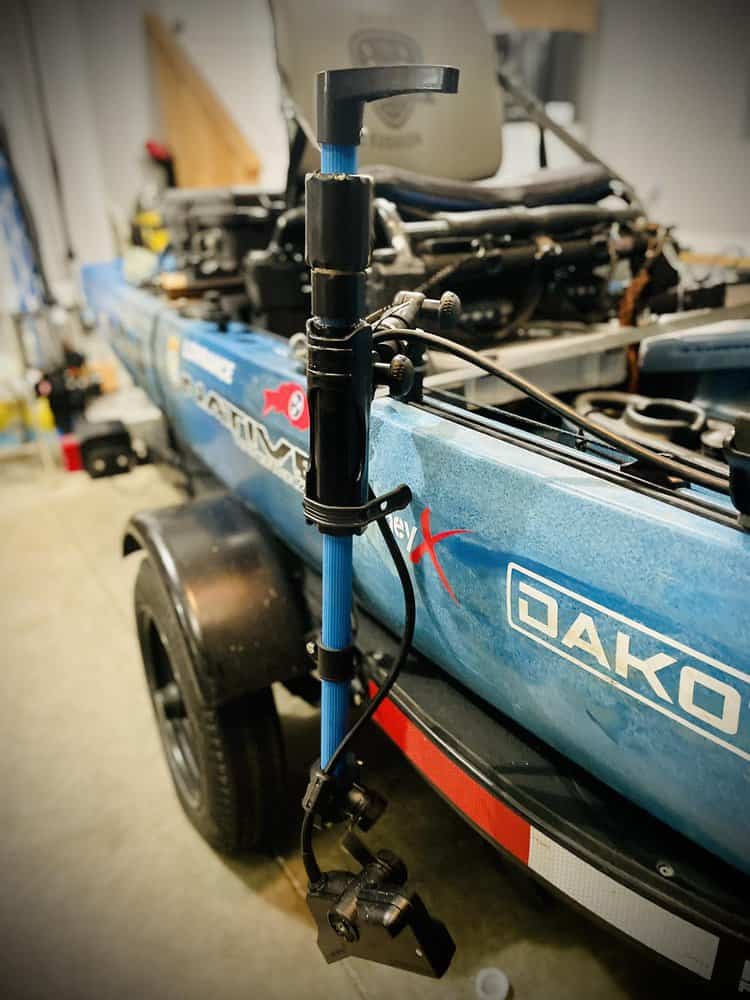
The DIY transducer mount in the picture above utilizes a mix of repurposed and standard components to create a functional and cost-effective mounting solution. Here’s a breakdown of the setup:
- Railblaza Rod Holder: This is the base of the mount, which is designed to hold fishing rods but is being repurposed to hold the transducer mount. Railblaza is known for its modular and versatile mounting systems, which are quite popular in the kayaking community.
- 6” Piece of 1-1/4” PVC: PVC pipe is often used in DIY projects for its durability, ease of use, and flexibility. In this setup, a piece of PVC serves as the main shaft of the mount, connecting the rod holder to the transducer. The diameter of 1-1/4” suggests it’s sturdy enough to support the transducer without too much flex.
- Modified Telescopic Pool Cleaning Net: The telescopic pole from a pool cleaning net has been repurposed here for providing adjustable length. This feature could be very useful for positioning the transducer at the correct depth in the water.
- Old Native Rudder Handle: The handle from a Native kayak rudder has been used to top off the mount, probably to provide a grip for easy adjustment or repositioning of the entire mount. This implies that the mount can be manually rotated or angled as needed.
Best Fish Finder Mounts for Boats
The best mount for a fish finder can vary significantly from boat to boat, depending on the boat’s size, design, and intended use, as well as the angler’s personal preferences and the specific fish finder model. Each vessel may have different mounting options and limitations, so it’s important to choose a mount that is compatible with both the boat and the device.
Kayak
The best mount for Kayak fish finder need to be compact, adjustable, and minimally invasive, given the limited space and the need to avoid interfering with the kayak’s operation. Here are some popular options:
- Track Mounts: Many fishing kayaks come with built-in tracks that allow for easy attachment of mounts without drilling. Track mounts are versatile and can be adjusted along the track for the best positioning.
- Scotty or RAM Mounts: These brands offer a wide range of mounting options, from rod holder mounts to fully adjustable arms that can be fitted to various points on a kayak.
- Transducer Arm Mounts: These mounts extend over the side of the kayak and dip the transducer directly into the water, ideal for kayaks without a scupper hole to accommodate a transducer.
Jon Boat
Jon boats, with their flat and open design, provide a versatile platform for mounting fish finders. Here are some of the best mounting options suitable for Jon boats:
- Gimbal Mounts: These come standard with many fish finders and allow for easy adjustment of the display. They can be mounted directly onto the flat surface of a Jon boat’s bench or console.
- Swivel Mounts: These allow the fish finder to rotate 360 degrees, providing flexibility in viewing angles. They can be attached to any flat surface on the boat.
- RAM Mounts: Known for their durability and adjustability, RAM mounts are a great fit for Jon boats. They offer different bases to suit various mounting locations, such as flat surfaces, rails, or even on the bow.
Bass Boat
For bass boats, which often have more space and a variety of potential mounting locations compared to kayaks, the best fish finder mounting options are those that offer stability, clear visibility, and quick access for the angler. Here are some of the top choices:
- Bow Mounts: If you fish from the front of the bass boat, a bow mount for an additional fish finder can be an excellent option. These are often mounted on the bow panel or on a separate bracket that allows for easy viewing while fishing from the front deck.
- Gimbal Mounts: These are standard mounts that come with many fish finders, allowing for easy tilting and rotation of the display. They are typically mounted directly on the dash or on a shelf in the console area.
- In-Dash Mounts: Some bass boats come with designated spots for in-dash electronics. These can be great for larger fish finders and can often be integrated with other boat systems.
Pontoon Boat
Mounting a fish finder on a pontoon boat offers unique challenges and opportunities due to the pontoon boat’s design and layout. Here are some of the best fish finder mounting options suitable for pontoon boats:
- Rail Mounts: Pontoon boats often have accessible railing systems where rail mounts can be easily clamped on without the need for drilling holes. These mounts are adjustable and can be moved along the rail to the desired location.
- Flush Mounts: If you have a console or helm with enough space, a flush mount can provide a clean and professional look. This option requires cutting into the console, so it’s more permanent and should be done with care to maintain the integrity of the boat’s structure.
- Universal Mounting Systems: Brands like RAM and Scotty offer a variety of mounting systems that can be adapted to a pontoon boat’s specific needs, allowing for flexible placement and easy adjustment of the fish finder.

